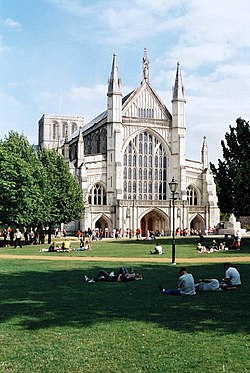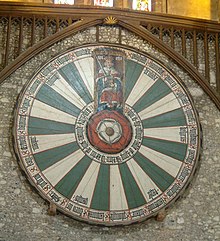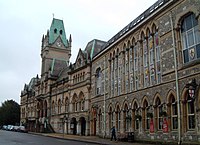Winchester: Difference between revisions
Created page with '{{Infobox town |name=Winchester |county=Hampshire |picture=Winchester Cathedral 2004.JPG |picture caption=Winchester Cathedral |os grid ref=SU485295 |latitude=51.0632 |longitude=…' |
|||
| Line 105: | Line 105: | ||
*[http://www.geograph.org.uk/search.php?i=3349740 www.geograph.co.uk : photos of Winchester and surrounding area] | *[http://www.geograph.org.uk/search.php?i=3349740 www.geograph.co.uk : photos of Winchester and surrounding area] | ||
*[http://www.winchesterlocal.co.uk/ Winchester local shops, hospitals, schools and attractions] | *[http://www.winchesterlocal.co.uk/ Winchester local shops, hospitals, schools and attractions] | ||
{{Cities in the United Kingdom}} | |||
Revision as of 15:01, 30 March 2016
| Winchester | |
| Hampshire | |
|---|---|
 Winchester Cathedral | |
| Location | |
| Grid reference: | SU485295 |
| Location: | 51°3’48"N, 1°18’31"W |
| Data | |
| Population: | 41,420 (2001) |
| Post town: | Winchester |
| Postcode: | SO22, SO23 |
| Dialling code: | 01962 |
| Local Government | |
| Council: | Winchester |
| Parliamentary constituency: |
Winchester |
Winchester is the county town of Hampshire. It stands at the western end of the South Downs, along the course of the River Itchen.
Winchester is a historic cathedral city and the ancient capital of Wessex and of the Kingdom of England. It developed from the Roman town of Venta Belgarum.
Winchester's major landmark is Winchester Cathedral, one of the largest cathedrals in Britain, with the distinction of having the longest nave and overall length of all Gothic cathedrals in Europe. The town is also home to Winchester College, the famous Public School. A new Winchester University was founded as such in June 2005 out of King Alfred's College, founded as the Winchester Diocesan Training School in 1840.
The city's architectural and historic interest, and its fast links to other towns and cities have led Winchester to become one of the most expensive and desirable areas of the country.[1] A person who is from or resides in Winchester is locally known as a Wintonian.
Winchester railway station is served by trains running from London Waterloo, Weymouth, Portsmouth, Southampton and the North.
Name

The name of Winchester is of ancient origin. When the Romans arrived under the Emperor Claudius the town was already established and is assumed to have borne the British name "Venta" or similar. The Romans refounded the town and named it Venta Belgarum after the local Belgii tribe, to distinguish it from others of the same name, particularly Venta Silurum (Caerwent). Venta is the equivalent of the Modern Welsh Gwent. In Nennius's list of the cities of Britain, Winchester is apparently that named Cair Guinntguic. The Saxons arrived in 519 or thereabouts and under them the name became in the Old English tongue Wintanceaster ("Wenta-city"). From this comes the modern name "Winchester".
The Bishop of Winchester signs as "Winton", short for Wintonceastrium, derived from the Old English name.
History
Early history
Settlement in the area dates back to before Roman times, with an Iron Age enclosure or valley fort, Oram's Arbour, on the western side of the present-day city. After the Roman conquest of Britain the civitas, then named Venta Belgarum was of considerable importance.[2]
Anglo-Saxon times

The Saxons came to Winchester in 519 or thereabouts. Archaeological evidence suggests a continuity of British town life in Winchester for some time, though this was in the heart of the English settlements in southern Britain and Winchester was to become the most important English city.
Winchester became the capital of the ancient kingdom of Wessex and was established too as the seat of a bishoprice possibly by King Cædwalla of Wessex. King Egbert consolidated his hold over Wessex after throwing off years of Mercian domination and extended his rule across the English kingdoms, establishing Winchester the main city in his kingdom in 827. Saint Swithun was Bishop of Winchester in the mid 9th century.
King Alfred established the city's street pattern, which is still evident today: a cross shaped street system which conformed to the standard town planning system of the day – overlaying the pre-existing Romano-British street plan (incorporating the ecclesiastical quarter in the south-east; the judicial quarter in the south-west; the tradesmen in the north-east). The town was part of a series of fortifications along the south coast. Built by Alfred to protect the Kingdom, they were known as 'burhs'. The mediæval city walls, built on the old Roman walls, are visible in places. Only one section of the original Roman walls remains. Four main gates were positioned in the north, south, east and west plus the additional Durngate and King's Gate. Winchester remained the capital of Wessex, and then England, until some time after the Norman Conquest when the capital was moved to London. The Domesday Book was compiled in the city early in the reign of William the Conqueror.
Nothing of the Royal Hall of pre-conquest Winchester survives, though across the High Street from its site stands God Begot House, which dates from 1050 and was once Queen Emma's residence. Bucchestret, now called Busket Lane contains St John's House with a vaulted kitchen, which may have formed part of the original Anglo-Saxon Almshouse there, part of tenth century charitable foundartion which is still operating.[3]
Middle Ages
The King's court moved to London at the beginning of the twelfth century and left Winchester a plain Hampshire market town. A serious fire in the city in 1141 accelerated its decline. However, William of Wykeham (1320–1404) played an important role in the city's restoration. As Bishop of Winchester he was responsible for much of the current structure of the cathedral, and he founded Winchester College, still a prestigious public school, whose boys are known as "Wykehamists". During the later Middle Ages, the city was an important centre of the wool trade, before going into a slow decline. The curfew bell in the bell tower (near the clock in the picture), still sounds at 8.00pm each evening. The curfew was the time to extinguish all home fires until the morning
Modern Age
In 1770, Thomas Dummer purchased the City Cross (also known as the Buttercross) from the Corporation of Winchester, intending to have it re-erected at Cranbury Park, near Otterbourne. When his workmen arrived to dismantle the cross, they were prevented from doing so by the people of the city, who "organised a small riot"[4] and they were forced to abandon their task. The agreement with the city was cancelled and Dummer erected a lath and plaster facsimile, which stood in the park for about sixty years before it was destroyed by the weather.[5] The Buttercross still stands in the High Street.
The famous novelist Jane Austen died in Winchester on 18 July 1817 and is buried in the cathedral. The Romantic poet John Keats stayed in Winchester from mid August through to October 1819. It was in Winchester that Keats wrote "Isabella", "St. Agnes' Eve", "To Autumn" and "Lamia". Parts of "Hyperion" and the five-act poetic tragedy "Otho The Great" were also written in Winchester.
Although Winchester City survived the Second First World Warntact, it did not survive modernist town planners so easily. About thirty percent of the Old Town was demolished to make way for buildings more suited to modern office day requirements (in particular for Hampshire County Council and Winchester City Council). Since the late 1980s the city has seen a gradual replacement of these post war brutalist structures for contemporary developments more sympathetic to the mediæval urban fabric of the Old Town.
Further learning
The City Museum located on the corner of Great Minster Street and The Square contains much information on the history of Winchester. Early examples of Winchester measures of standard capacity are on display.
Landmarks
The Cathedral

Winchester Cathedral, the longest cathedral in Europe, was originally built in 1079. It contains much fine architecture spanning the 11th to the 16th century and is the place of interment of numerous Bishops of Winchester (including William of Wykeham) and Kings of the English up to King William II.[6] Amongst other tombs here is that of Jane Austen.
The cathedral was once an important pilgrimage centre and housed the shrine of Saint Swithun. The plan of the earlier Old Minster is laid out in the grass adjoining the cathedral. The New Minster (the original burial place of Alfred the Great and Edward the Elder[6]) once stood beside it.
The Cathedral has a girls' choir and a boys' choir, which sing on a regular basis at the cathedral.
Cathedral Close
The Cathedral Close contains a number of historic buildings from the time when the cathedral was also a priory. Of particular note are the Deanery which dates back to the thirteenth century. It was originally the Prior's House, and was the birthplace of Arthur, Prince of Wales in 1486. Not far away is Cheyney Court, a mid fifteenth century Timber framing|timber framed house incorporating the Porter's Lodge for the Priory Gate. It was the Bishop's court house.
The earliest hammer-beamed building still standing in England is also situated in the Cathedral Close, next to the Dean's garden. It is known as the Pilgrims' Hall, as it was part of the hostelry used to accommodate the many pilgrims to Saint Swithun's shrine. Left-overs from the lavish banquets of the Dean would be given to the pilgrims who were welcome to spend the night in the hall. It is thought by Winchester City Council to have been built in 1308. Now part of The Pilgrims' School, the hall is used by the school for assemblies in the morning, drama lessons, plays, orchestral practices, Cathedral Waynflete rehearsals, the school's Senior Commoners' Choir rehearsals and so forth.
Wolvesey Castle and Palace
Wolvesey Castle was the Norman bishop's palace, dating from 1110, but standing on the site of an earlier Saxon structure. It was enhanced by Henry de Blois during the Anarchy of his brother King Stephen's reign. He was besieged there for some days. In the 16th century, Queen Mary I of England|Mary Tudor and King Philip II of Spain were guests just before their wedding in the Cathedral. The building is now a ruin (maintained by English Heritage), but the chapel was incorporated into the new palace built in the 1680s, only one wing of which survives.
Winchester Castle

The one remaining complete part of Winchester Castle is the Great Hall, which is one of the city's major visitor attractions. Apart from the hall, only a few excavated remains of the stronghold survive amongst the modern Law Courts attached to the Hall.
The Great Hall was built in the 12th century and was rebuilt at some time between 1222 and 1235, in which later form it still stands. It has served as the law courts for the city, and is now attached to a modern complex housing court buildings and offices.
The Great Hall is famous for King Arthur's Round Table, which has hung in the hall from at least 1463. Legend attributes it to the legendary King Arthur, though recetly and less romantically dendrochronology has determined that its timber was felled in 1275. Notwithstanding that Arhtur and his knights never drank mead at this round table, it is still of considerable historical interest and attracts many tourists. The table was originally unpainted, but King Henry VIII (whose elder brother was named Arthur) had it painted in 1522. The names of the legendary Knights of the Round Table are written around the edge of the table surmounted by King Arthur on his throne, a picture based on King Henry himself. Opposite the table are a modern ornament; Prince Charles's 'Wedding Gates', finely executed in keeping with the hall.
In the grounds of the Great Hall is a recreation of a mediæval garden.
The Castle became disused when supplanted by the King's House, now incorporated into the Peninsula Barracks where there are several military museums. Winchester is also home to the Army Training Regiment Winchester, otherwise known as Sir John Moore Barracks, where Army recruits undergo their phase one training.
Winchester College
The buildings of Winchester College, a public school founded by William of Wykeham, still largely date from their first erection in 1382. There are two courtyards, a gatehouse, cloister, hall, a magnificent college chapel and it also owns "The Water Meadows" through which runs a part of the River Itchen. It was planned to educate poor boys before they moved on to New College, Oxford and often a life in the church. The connection with New College remains.
Hospital of St Cross
The almshouses and vast Norman chapel of Hospital of St Cross were founded just outside the city centre by Henry de Blois in the 1130s. Since at least the 14th century, and still available today, a 'wayfarer's dole' of ale and bread has been handed out there.
Other buildings

Other important historic buildings include the Guildhall dating from 1871 in the Gothic revival style,[7] the Royal Hampshire County Hospital designed by William Butterfield and one of the city's several water mills driven by the various channels of the River Itchen that run through the city centre. Winchester City Mill, has recently been restored, and is again milling corn by water power. The mill is owned by the National Trust.
References
- ↑ "Winchester: Best and Worst Places to Live in the UK 2006 from channel4.com/4homes". Channel4.com. http://www.channel4.com/4homes/ontv/best&worst/2006/winchester.html. Retrieved 2009-05-06.
- ↑ Roman Britain.org Venta Belgarum
- ↑ St John's Winchester Charity - City of Winchester history
- ↑ "The Buttercross, Winchester". City of Winchester. 1998. http://www.cityofwinchester.co.uk/history/html/buttercross.html. Retrieved 23 September 2009.
- ↑ Yonge, Charlotte M. (1898). "Old Otterbourne". John Keble's Parishes – Chapter 8. www.online-literature.com. http://www.online-literature.com/charlotte-yonge/john-keble/8/. Retrieved 23 September 2009.
- ↑ 6.0 6.1 Dodson, Aidan. The Royal Tombs of Great Britain. London: Gerald Duckworth & Co. 2004.
- ↑ History of Winchester Guildhall
Outside links
- Winchester Cathedral
- Winchester City Council
- www.geograph.co.uk : photos of Winchester and surrounding area
- Winchester local shops, hospitals, schools and attractions
| Cities in the United Kingdom |
|---|
|
Aberdeen • Armagh • Bangor (Caernarfonshire) • Bangor (County Down) • Bath • Belfast • Birmingham • Bradford • Brighton and Hove • Bristol • Cambridge • Canterbury • Cardiff • Carlisle • Chelmsford • Chester • Chichester • Colchester • Coventry • Derby • Doncaster • Dundee • Dunfermline • Durham • Ely • Edinburgh • Exeter • Glasgow • Gloucester • Hereford • Inverness • Kingston upon Hull • Lancaster • Leeds • Leicester • Lichfield • Lincoln • Lisburn • Liverpool • City of London • Londonderry • Manchester • Milton Keynes • Newcastle upon Tyne • Newport • Newry • Norwich • Nottingham • Oxford • Perth • Peterborough • Plymouth • Portsmouth • Preston • Ripon • Rochester • Salford • Salisbury • Sheffield • Southampton • St Albans • St Asaph • St David's • Southend-on-Sea • Stirling • Stoke-on-Trent • Sunderland • Swansea • Truro • Wakefield • Wells • Westminster • Winchester • Wolverhampton • Worcester • Wrexham • York |